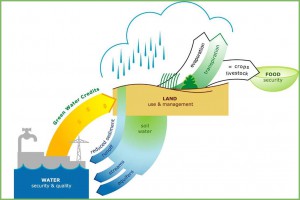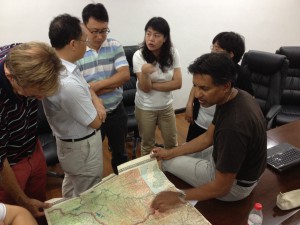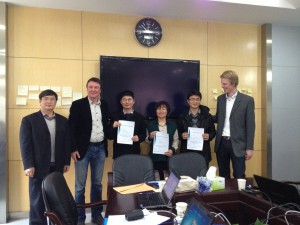In June 2012, a consortium of ISRIC, FutureWater, and Nelen en Schuurmans started the project, financed by Partners for Water/NL. Green Water Management & Credits is a concept that allows quantification of water supply and demand, erosion reduction, yield increase, sedimentation amounts, and hydropower production. These are needed to calculate the economic costs and benefits of environmental protection measures. In order to run this concept in areas, an analytical toolkit in combination with adequate database resources and knowhow is necessary. The project aims at future business cases for the partners involved, using the GWM&C concept and toolkit. We are working closely with local/regional partners in China: CWRC, CWRPI, Huazhong Agricultural University, and North West Agricultural & Forest University.

Figure: Green Water (visit www.greenwatercredits.net)
In September 2012, the official kickoff took place in Wuhan/Hubei Province. Leaders of the Yangtze River Commission and the CWRPI attended the ceremony. Also, the training of local staff and students started. We focused on the GWM&C concept, the WOCAT-SOTER databases, and our hydrological assessment tools. We selected the 12,000 km2 Duhe basin to be our study area, as an important contributory source of water, located south-west from the Danjiangkou Reservoir. Together with our Chinese partners, the data needs were determined to build, calibrate, and validate our models. Our local partners are successfully collecting data for the project, which we combine with global data sets available.

Picture: Discussion on basin area selection at the Danjiangkou Reservoir.
In the second week of January 2013, staff of FutureWater successfully accomplished the second training in Wuhan. Staff of the CWRPI and university students attended the training that focused on the application of the SWAT model on the Duhe basin. We started with expectations of the trainees and trainers, followed by the basin area water balance setup, components, and data used. We introduced the SWAT model with tutorials and the first version of the Duhe model, already setup in The Netherlands. During the week, we went from water and sediment challenges in the basin area to green water measures, and from these measures to the SWAT model. We discussed the data needed still and evaluated the training session. At the end, each trainee was handed over a Certificate of Completion.

Picture: Staff of CWRPI with their Certificates of Completion, together with FutureWater trainers and ISRIC staff of the GWM&C China project.
More information regarding this project can be found on the project page.
